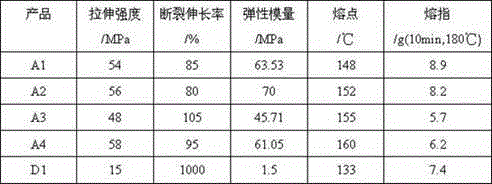Copolyester used as 3D printing material and preparation method of copolyester
A 3D printing and copolyester technology, which is applied in the field of copolyester as a 3D printing material and its preparation, can solve problems such as poor mechanical properties of copolyester, complicated preparation methods, and limited applications, so as to avoid compatibility Problems, simple preparation process, good thermal stability
- Summary
- Abstract
- Description
- Claims
- Application Information
AI Technical Summary
Problems solved by technology
Method used
Image
Examples
Embodiment 1
[0021] 166g (1mol) of terephthalic acid, 11.62g (0.07mol) of isophthalic acid, 20.2g (0.1mol) of sebacic acid, 111.6g (1.24mol) of 1,4-butanediol, 26g of neopentyl glycol (0.25mol), 17.7g (0.15mol) of hexanediol, and 0.1187g of titanium / tin composite catalyst were added to a 1L reactor. The reaction kettle is equipped with stirring, temperature measuring system, rectification column and reflux condenser. After gradually raising the temperature to 100°C, the stirring is started. When the temperature is close to 175°C, water begins to distill out, and the distillation temperature is 98-100°C. Raise the temperature to about 215°C, and the esterification reaction ends when the water output reaches more than 95% of the theoretical value. Then add 0.3956g antioxidant, 39.5641g additive (carbon nanotube) and 1.1869g additive (oleic acid) to carry out reduced pressure polymerization reaction, gradually increase the temperature to 255 ° C, keep warm; the pressure in the reactor is grad...
Embodiment 2
[0023] Terephthalic acid 166g (1mol), isophthalic acid 19.92g (0.12mol), sebacic acid 18.18g (0.09mol), 1,4-butanediol 96.3g (1.07mol), neopentyl glycol 66.56 g (0.64mol), 12.98g (0.11mol) of hexanediol, and 0.1021g of titanium / tin composite catalyst were added to a 1L reactor. The reaction kettle is equipped with stirring, temperature measuring system, rectification column and reflux condenser. After gradually raising the temperature to 100°C, the stirring is started. When the temperature is close to 175°C, water begins to distill out, and the distillation temperature is 98-100°C. Raise the temperature to about 215°C, and the esterification reaction ends when the water output reaches more than 95% of the theoretical value. Then add 0.2041g antioxidant, 30.6152g additive (nano silicon dioxide) and 2.0410g auxiliary agent (polyethylene wax) to carry out reduced-pressure compression polymerization reaction, gradually increase the temperature to 255 ° C, keep warm; the pressure i...
Embodiment 3
[0025] Terephthalic acid 166g (1mol), isophthalic acid 24.9g (0.15mol), sebacic acid 30.3g (0.15mol), 1,4-butanediol 93.6g (1.04mol), neopentyl glycol 86.32 g (0.83mol), 24.78g (0.21mol) of hexanediol, and 0.0885g of titanium / tin composite catalyst were added to a 1L reactor. The reaction kettle is equipped with stirring, temperature measuring system, rectification column and reflux condenser. After gradually raising the temperature to 100°C, the stirring is started. When the temperature is close to 175°C, water begins to distill out, and the distillation temperature is 98-100°C. Raise the temperature to about 215°C, and the esterification reaction ends when the water output reaches more than 95% of the theoretical value. Then add 0.6636g of antioxidant, 26.5443g of additive (graphene oxide) and 1.1062g of additive (sodium polyamide) to carry out reduced-pressure compression polymerization reaction, gradually increase the temperature to 255°C and keep it warm; the pressure in ...
PUM
| Property | Measurement | Unit |
|---|---|---|
| tensile strength | aaaaa | aaaaa |
| elongation at break | aaaaa | aaaaa |
Abstract
Description
Claims
Application Information
 Login to View More
Login to View More - R&D
- Intellectual Property
- Life Sciences
- Materials
- Tech Scout
- Unparalleled Data Quality
- Higher Quality Content
- 60% Fewer Hallucinations
Browse by: Latest US Patents, China's latest patents, Technical Efficacy Thesaurus, Application Domain, Technology Topic, Popular Technical Reports.
© 2025 PatSnap. All rights reserved.Legal|Privacy policy|Modern Slavery Act Transparency Statement|Sitemap|About US| Contact US: help@patsnap.com

